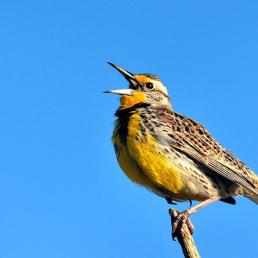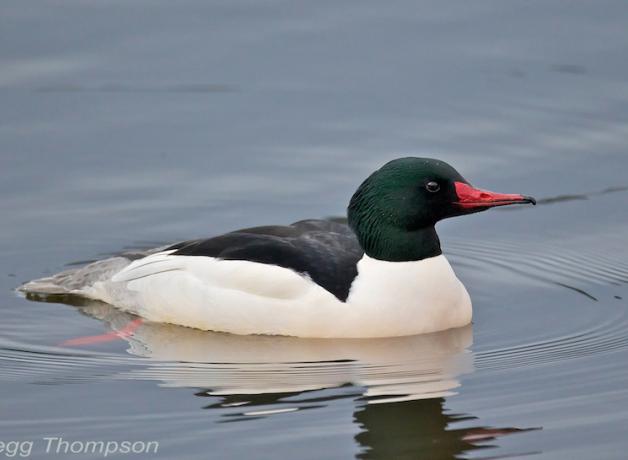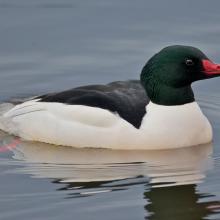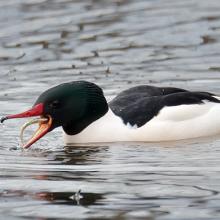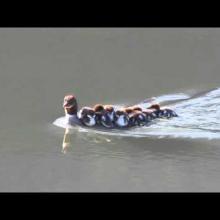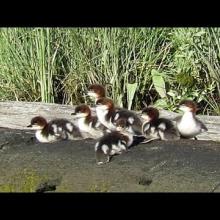

Join BirdNote tomorrow, November 30th!
Illustrator David Sibley and actor H. Jon Benjamin will face off in the bird illustration battle of the century during BirdNote's Year-end Celebration and Auction!
The Common Merganser is one of our biggest ducks, about the size of some loons. Although it’s not closely related to loons, it has evolved a similar overall structure and predatory behavior. But a merganser has a unique feature: tooth-like serrations along the edge of the bill that help the bird grasp slippery fish. Common Mergansers nest in the northern states and Canada. So do loons. But loons nest on the ground at the edge of a lake, while the mergansers nest mostly in tree cavities and rock crevices near large lakes or along rivers.
BirdNote®
Common Mergansers Parallel Loons
Written by Bob Sundstrom
This is BirdNote.
[Common Merganser calling - file from Lang Elliott]
On a northern lake surrounded by dense evergreens, a large water bird rests on the surface. Its long, slim body – more than two feet of it – appears mostly white, the back black, the head a deep green. And all of it glistens.
The bird dives under, a graceful sliding motion. Then returns to the surface with a fish grasped firmly in its beak.
The bird’s shape and behavior spell “loon.” [Common Loon brief vocalization, http://macaulaylibrary.org/audio/43039, 0.35-.38] But this is a male Common Merganser, a very large duck that hunts fish for a living. [Common Merganser calling, http://macaulaylibrary.org/audio/61558, 0.14-.17]
The Common Merganser is one of our biggest ducks, about the size of some loons, or even a small goose. Although it’s not closely related to loons, it has evolved a similar overall structure and predatory behavior. But a merganser has a unique feature that a loon lacks: tooth-like serrations along the edge of the bill that help the bird grasp slippery fish.
Common Mergansers nest in the northern states and Canada. So do loons. But loons nest on the ground, while mergansers nest mostly in tree cavities and rock crevices. Cavities big enough to house a hefty 3½-pound female, plus about a dozen jumbo eggs.
For BirdNote, I’m Michael Stein.
###
Bird sounds recorded by Lang Elliot, musicofnature.com: Common Loon brief vocalization, 43039 and 61558 recorded by William W. H. Gunn; and are provided by The Macaulay Library of Natural Sounds at the Cornell Lab of Ornithology, Ithaca, New York.
BirdNote’s theme music was composed and played by Nancy Rumbel and John Kessler.
Producer: John Kessler
Executive Producer: Sallie Bodie
© 2016 Tune In to Nature.org September 2016 / 2021 Narrator: Michael Stein
ID# COME-02-2016-09-21 COME-02
